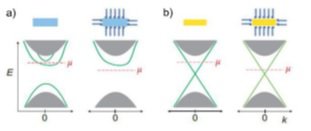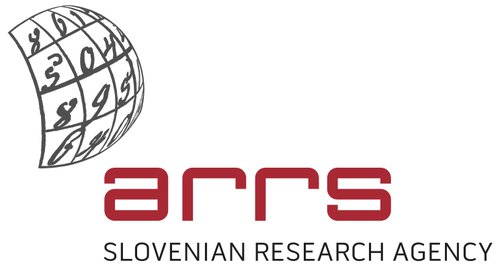Exploitation of localized surface plasmon resonance (LSPR) for detection of nanoparticle topological surface states (TSS) and development of new photo-thermal topological insulator nanomaterials
Project content and funding
Topological insulators (TI) are recently discovered materials that gained significant attention due to attractive electronic properties of their surfaces. These properties result from metalic, linearly dispersed, spin-polarized surface states, which are widely known as topological surface states (TSS). To imagine it more easily, TI are materials like ordinary insulators with a bulk insulating energy gap, but they also possess gapless TSS which are present at the boundaries (surfaces or edges). Unlike conventional surface states that can be easily modified or even destroyed by adsorbents, contamination or dopants, TSS are quite roboust to an almost any type of non-magnetic impurities and disorders (Fig. 1). Reason is the combined effect of the time-reversal symetry and spin orbit coupling. These peculiar properties make the TI very promising material for novel applications such as quantum computing, THz detectors, plasmonics, spintronics and even as a photo-thermal conversion agents in the form of nanoparticles. Among the TI, the most promising material is bismuth selenide (Bi2Se3), due to its narrow bulk band-gap (0.3 eV).

However, due to the big rush towards the miniaturization of some above-mentioned applications, at some point, the nanoparticles will need to be used. The main problem that limits the development and application of the TI nanoparticles for years is the detection of TSS, the features that define them. The TSS on the nanoparticles can not be detected by using already known conventional methods (e.g. angle-resolved photoemission spectroscopy –ARPES, scanning tunnelling spectroscopy – STS, transport measurements) because of their limitations. Therefore, due to the variety of factors (e.g. dopant concentration, critical thickness, synthesis method), that can destroy the TSS, we are never sure, if the synthesized nanoparticles are really TI or not. Considering the above-mentioned problems of this field, the goal of the project is the development of a new, easy and quick method for the detection of TSS, directly on the nanoparticles. The development of such method could be seen as a milestone in the field of the TI, since the detection of the TI character is very important for the development of new TI nanomaterials and applications that rely on them.
The proposed method is based on the detecting of TSS directly on the nanoparticles by observing the absorption modes related to the localized surface plazmon resonance (LSPR) by using the UV-vis spectroscopy. The concept that LSPR could be taken as a proof of the existance of TSS was theoretically predicted few years ago, but just recently it was also experimentally confirmed by us. Reed more here.
For the purpose of the development of the method, different Bi2-xAxSe3 (A=M3+) nanoparticles will be prepared, since it was mentioned that up to the certain concentration, dopants can also disturb the existence of TSS. The absorbance will be then measured using two different systems that use different optic geometry; conventional UV-vis spectrometer and microtiter plate reader. For validation of this method, the results will be compared with results obtained by a conventional method for the detection of TSS (ARPES). This will be performed on the single-crystal counterparts. Moreover, by developing this new method, we will also be able to determine the critical concentration of the dopants, where TSS of the nanoparticles disappear. This is very important for the development of new TI nanomaterials, which leads us to our second part of the project.
The new method will also allow us to detect the potential photo-thermal TI nanoparticles. The LSPR is responsible for the existence of the photo-thermal effect, which can be used, for example, in medicine. Therefore, the second goal of the project is the study of the photo-thermal effect of TI nanoparticles and development of new photo-thermal TI nanomaterials with controllable heating magnitude. The detection of LSPR and further photo-thermal experiments will expand the applicability of the TI nanoparticles in the fields such as biomedicine, plasmonic-assisted nanochemistry, sensors, thermal microbiology etc.
Project duration: 1. 9. 2020-31. 8. 2022
Funding: Project is founded by Slovenan Research Agency (Project Number: Z2-2644)
Project team
- Dr. Blaž Belec (principal investigator) SICRIS
- Prof. Dr. Matjaž Valant SICRIS
- Prof. Dr. Mattia Fanetti SICRIS
- Prof. Dr. Sandra Gardonio SICRIS
- Dr. Nina Kostevšek (collaboration with JSI) SICRIS
Project phases
WP1: Development and validation of the method for detection of TSS on the nanoparticles by measuring their absorbance
- T1: preparation of the single-crystals with different Bi2-xAxSe3 compositions (not achieved)
- T2: Determination of TSS on the single-crystal samples using ARPES (not achieved)
- T3: Preparation of adsorbent-free Bi2-xAxSe3 nanoparticles (finished)
- T4: Determination of TSS on the nanoparticles by absorption measurement (finished)
WP2: Study of photo-thermal effect on TI nanoparticles and development of photo-thermal TI nanomaterials
- T1: Measurements of the nanoparticles photo-thermal effect (finished)
- T2: Study of correlation between existence dopant concentration, TSS and heating effect (finished)
Additional research conducted under the project
- Investigation of the optical and photo-thermal properties of Bi2Se3 topological insulator related to the thickness of the coating layer on the nanoparticles surface
Bibliography
https://www.nature.com/articles/s41598-019-55646-1
Research articles:
- Inherent surface properties of adsorbent-free ultrathin Bi2Se3 topological insulator platelets (https://www.mdpi.com/2079-4991/13/5/809)
- Silica coated Bi2Se3 topological insulator nanoparticles: An alternative route to retain their optical properties and make them biocompatible ( https://www.mdpi.com/2079-4991/13/5/809)
Conference abstracts:
- 2022, Slovenian Microscopy symposium: Optical response of plasmonic Bi2Se3 topological insulator nanoplatelets investigated by cathodoluminescence microscopy.
- 2022, ICPPP21- International conference on photoacoustic and photothermal phenomena: Topological insulator nanoparticles : material with prospect for photo-thermal applications.
- 2022, Slovenian Chemical days: Exploitation of localized surface plasmon resonance for detection of nanoparticle's topological surface states
- 2021, Slovenian Chemical days: Silica coated Bi2Se3 topological insulator nanoplatelets: the way of making them colloidally stable but preserving their optical properties.

ARRS – Javna agencija za raziskovalno dejavnost Republike Slovenije
